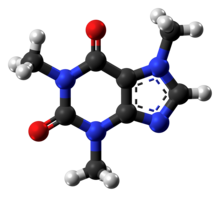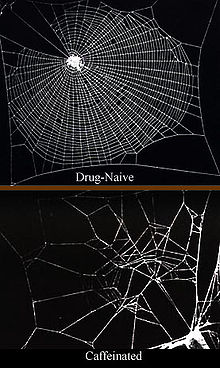Caffeine
 | |
 | |
| Clinical data | |
|---|---|
| Pronunciation | /kæˈfiːn,ˈkæfiːn/ |
| Synonyms | Guaranine Methyltheobromine 1,3,7-Trimethylxanthine 7-methyltheophylline[6]Theine |
| AHFS/Drugs.com | Monograph |
| Pregnancy category |
|
| Dependence liability | Physical:low–moderate[1][2][3][4] Psychological:low[5] |
| Addiction liability | Low[4]/ none[1][2][3] |
| Routes of administration | By mouth,insufflation,enema,rectal,intravenous |
| Drug class | Stimulant |
| ATC code | |
| Legal status | |
| Legal status |
|
| Pharmacokineticdata | |
| Bioavailability | 99%[8] |
| Protein binding | 25–36%[7] |
| Metabolism | Primary:CYP1A2[7] Minor:CYP2E1,[7]CYP3A4,[7] CYP2C8,[7]CYP2C9[7] |
| Metabolites | Paraxanthine(84%) Theobromine(12%) Theophylline(4%) |
| Onset of action | ~1 hour[8] |
| Eliminationhalf-life | Adults: 3–7 hours[7] Infants (full term): 8 hours[7] Infants (premature): 100 hours[7] |
| Duration of action | 3–4 hours[8] |
| Excretion | Urine (100%) |
| Identifiers | |
| |
| CAS Number | |
| PubChemCID | |
| IUPHAR/BPS | |
| DrugBank | |
| ChemSpider | |
| UNII | |
| KEGG | |
| ChEBI | |
| ChEMBL | |
| PDBligand | |
| ECHA InfoCard | 100.000.329 |
| Chemical and physical data | |
| Formula | C8H10N4O2 |
| Molar mass | 194.19 g·mol−1 |
| 3D model (JSmol) | |
| Density | 1.23 g/cm3 |
| Melting point | 235 to 238 °C (455 to 460 °F) (anhydrous)[9][10] |
| |
| |

Caffeineis acentral nervous system(CNS)stimulant.It is in themethylxanthineclass. It is found in manyplants,and is used in drinks likecoffee,someteas,somesoft drinks,andenergy drinks.It can be harmful for both humans and animals if a large amount is consumed. If a person ate 10-13 grams of caffeine quickly, between 80 and 100 cups ofcoffee,they wouldoverdoseand may die.[11]It is the world's most popularpsychoactive drug,and is legal in nearly all of the world.[12]
Sources
[change|change source]Caffeine is the main drug that is incoffee.Coffee comes from a tree. The seeds of the tree are roasted to make coffee.
Caffeine comes from other plants as well. It is in guarana, yerba maté,cacao,and some plants used to maketea.The plants use caffeine as apesticide.This is a chemical that kills insects if they eat the plant. It is the way the plant protects itself.
Caffeine was first extracted from cocoa beans into its purest form which is a white powder and the word originated from the German word “kaffee” and the French word “café” which both mean caffeine.[13]
It is calledguaraninewhen it comes from theguaranaplant andtheinewhen it comes from ateaplant. It is calledmateinein themate drink.This drink is an infusion made withYerba mate.
What caffeine is
[change|change source]
Caffeine is astimulantdrug.A stimulant is a drug that increases body actions likeheartrate,blood pressure,andmetabolism.It makes a person more awake and alert.
Caffeine also is adiuretic.This means it makes a person make moreurine(the waste liquid a person makes).
The caffeinechemicalis called axanthine alkaloid.This is a group of chemicals that are stimulants. Some xanthine alkaloids (like theophylline) are used to helpasthma.
What caffeine is used for
[change|change source]The biggest use of caffeine is as a stimulant. People drink coffee and other drinks with caffeine to stay awake.
Doctorssometimes use caffeine as amedicine.It is used forheadaches(head pain). It is sometimes used to help premature (bornveryearly) babies to breathe. The short-term risk of this treatment seems to be that the babies treated gain less weight than usual.[14]
Caffeine is sometimes given to people after alumbar puncture.This is a test to see if someone hasmeningitis.
In the beginning caffeine was found to relieve hunger, so it was used for weight loss. That did not last because people were using too much. Caffeine can be a very dangerous drug when not used in the right way.
Caffeine also has medicinal properties. It is used in many over the counter medicines, such as Excedrin, Midol and Anacin. When combined with otheranalgesics,caffeine can help to alleviate headaches and cramps.
Problems with caffeine
[change|change source]
The largest problem with caffeine isaddiction.This is when people get badsymptomswhen they do not have the drug. When people havewithdrawal(feel bad because they do not have the drug) they drink more. This makes them feel better. But if they cannot get more, they are likely to feel some of the symptoms listed below:
- Headaches
- Being tired or need to sleep
- Caffeine inhibits sleep and in the long-term alters brain functions
- Sleep deprivation leads to a weakened connectivity between the amygdala and medial prefrontal cortex which regulate mood and emotion.
- This causes the consumer to feel irritable, tired, restlessness, and anxious.
- Sleep deprivation leads to a weakened connectivity between the amygdala and medial prefrontal cortex which regulate mood and emotion.
- Nausea(feeling likevomiting)
Caffeine can also hurt people if they drink a lot at once. If someone takes too much of a drug at once it is called anoverdose.Caffeine overdose is amedical diagnosis.It is called:Caffeine-Induced Organic Mental DisorderorCaffeine Intoxication.People with this can have these symptoms:
- Very bad feelings like:
- Musclemovements that cannot be stopped
- Very fastheartrate
- Abnormal heart rhythms (even heart stopping)
- Very high blood pressure
- Vomiting
- Confusion(not knowing who the person is or where he/she is)
Caffeine helps for
[change|change source]Caffeine also has some strong advantages:[15]
- Lower risk ofcoronary disease
- Cutstrokerisk
- Speed up metabolism
- Increases memory
- Helps ward offAlzheimer’s
- Reduces kidney stone risk
How much caffeine is safe
[change|change source]250–300 mg of caffeine a day is amoderateamount. That is as much caffeine that is in three cups of coffee (8oz each cup). More than 750–1000 mg a day is a significant amount, but is very unlikely to kill someone. TheLethal Dose 50of caffeine is 192 mg per kilogram, in rats. In humans, it is between 150 and 200 mg per kilogram (70-90 per pound.)
Caffeine is in many drinks and foods. This isapproximateamounts of caffeine in some food and drink:
- Brewed coffee – 40 to 220 mg in a cup
- Instant coffee – 30 to 120 mg in a cup
- Decaffeinatedcoffee (with most caffeine taken out) – 3 to 5 mg in a cup
- Tea – 20 to 110 mg in a cup
- Soda drinks with caffeine – 36 to 90 mg in 12 ounces. Some people think that soft drinks which are light in color do not contain caffeine. This is not always true.
- Milkchocolate– 3 to 6 mg in an ounce
- Bittersweet chocolate – 25 mg in an ounce
One ounce –abbreviatedoz – is 30 ml.
A 'cup' is 8 oz (240 ml.)
Different ways to get 200mg of caffeine
[change|change source]| Caffeine equivalents[16][17] |
|---|
In general, each of the following contains approximately 200milligramsof caffeine:
Notes: Afluid ounceis between 28 and 30 millilitres. a. There may also be large amounts of other chemicals, similar to caffeine inChocolateand other products ofcacao.There istheobrominein cacao, for example. These substances can have effects similar to those of caffeine. b. Most tea drunk in North America is not very strong. The figures are for this kind of tea. The tea drunk in most other places of the world is stronger; for these kinds of tea, the figures are probably too small. |
References
[change|change source]- ↑1.01.1Malenka RC, Nestler EJ, Hyman SE (2009). "Chapter 15: Reinforcement and Addictive Disorders". In Sydor A, Brown RY (eds.).Molecular Neuropharmacology: A Foundation for Clinical Neuroscience(2nd ed.). New York: McGraw-Hill Medical. p. 375.ISBN978-0-07-148127-4.
Long-term caffeine use can lead to mild physical dependence. A withdrawal syndrome characterized by drowsiness, irritability, and headache typically lasts no longer than a day. True compulsive use of caffeine has not been documented.
- ↑2.02.1Karch SB (2009).Karch's pathology of drug abuse(4th ed.). Boca Raton: CRC Press. pp. 229–230.ISBN978-0-8493-7881-2.
- ↑3.03.1American Psychiatric Association (2013)."Substance-Related and Addictive Disorders"(PDF).American Psychiatric Publishing. pp. 1–2. Archived fromthe original(PDF)on 15 August 2015.Retrieved10 July2015.
Substance use disorder in DSM-5 combines the DSM-IV categories of substance abuse and substance dependence into a single disorder measured on a continuum from mild to severe.... Additionally, the diagnosis of dependence caused much confusion. Most people link dependence with "addiction" when in fact dependence can be a normal body response to a substance.... DSM-5 will not include caffeine use disorder, although research shows that as little as two to three cups of coffee can trigger a withdrawal effect marked by tiredness or sleepiness. There is sufficient evidence to support this as a condition, however it is not yet clear to what extent it is a clinically significant disorder.
- ↑4.04.1Introduction to Pharmacology(third ed.). Abingdon: CRC Press. 2007. pp. 222–223.ISBN978-1-4200-4742-4.
- ↑Juliano LM, Griffiths RR (October 2004)."A critical review of caffeine withdrawal: empirical validation of symptoms and signs, incidence, severity, and associated features".Psychopharmacology.176(1): 1–29.doi:10.1007/s00213-004-2000-x.PMID15448977.S2CID5572188.
- ↑"Caffeine".ChemSpider.Retrieved16 November2021.
- ↑7.07.17.27.37.47.57.67.77.8"Caffeine".DrugBank.University of Alberta. 16 September 2013.Retrieved8 August2014.
- ↑8.08.18.2Poleszak E, Szopa A, Wyska E, Kukuła-Koch W, Serefko A, Wośko S, Bogatko K, Wróbel A, Wlaź P (February 2016). "Caffeine augments the antidepressant-like activity of mianserin and agomelatine in forced swim and tail suspension tests in mice".Pharmacological Reports.68(1): 56–61.doi:10.1016/j.pharep.2015.06.138.PMID26721352.S2CID19471083.
- ↑"Caffeine".Pubchem Compound.NCBI.Retrieved16 October2014.
Boiling Point
178 °C (sublimes)
Melting Point
238 DEG C (ANHYD) - ↑"Caffeine".ChemSpider.Royal Society of Chemistry.Retrieved16 October2014.
Experimental Melting Point:
234–236 °C Alfa Aesar
237 °C Oxford University Chemical Safety Data
238 °C LKT Labs [C0221]
237 °C Jean-Claude Bradley Open Melting Point Dataset 14937
238 °C Jean-Claude Bradley Open Melting Point Dataset 17008, 17229, 22105, 27892, 27893, 27894, 27895
235.25 °C Jean-Claude Bradley Open Melting Point Dataset 27892, 27893, 27894, 27895
236 °C Jean-Claude Bradley Open Melting Point Dataset 27892, 27893, 27894, 27895
235 °C Jean-Claude Bradley Open Melting Point Dataset 6603
234–236 °C Alfa Aesar A10431, 39214
Experimental Boiling Point:
178 °C (Sublimes) Alfa Aesar
178 °C (Sublimes) Alfa Aesar 39214 - ↑"Can caffeine kill you?".Livescience.com.25 September 2012.Retrieved19 February2016.
- ↑Burchfield G (1997). Meredith H (ed.)."What's your poison: caffeine".Australian Broadcasting Corporation. Archived fromthe originalon 26 July 2009.Retrieved15 January2014.
- ↑"History and Background".Caffeine.2012-09-12.Retrieved2018-11-18.
- ↑Schmidt, B; Roberts, RS; Davis, P; Doyle, LW (May 18, 2006)."Caffeine therapy for apnea of prematurity".New England Journal of Medicine.354(20): 2112–21.doi:10.1056/NEJMoa054065.PMID16707748.S2CID22587234.
- ↑"The Advantages and Disadvantages Of Drinking Coffee | Coffee Corner".Coffee Corner.2017-10-26.Retrieved2017-12-03.
- ↑"Caffeine Content of Food and Drugs".Nutrition Action Health Newsletter.Center for Science in the Public Interest. December 1996. Archived fromthe originalon 2007-06-14.Retrieved2006-08-22.
- ↑"Caffeine Content of Beverages, Foods, & Medications".The Vaults of Erowid. July 7, 2006.Retrieved2006-08-22.
Other websites
[change|change source]Scientific information
[change|change source]- eMedicine Caffeine-Related Psychiatric Disorders
- The Consumers Union Report on Licit and Illicit Drugs, Caffeine-Part 1Part 2
- The Physician and Sportsmedicine:Caffeine: A User's GuideArchived2008-06-21 at theWayback Machine
- Caffeine: Psychological Effects, Use & AbuseArchived2007-04-03 at theWayback Machine
- Caffeine Withdrawal Recognized as a DisorderArchived2010-08-23 at theWayback Machine
- Is Caffeine a Health Hazard?
Others
[change|change source]- Caffeine Withdrawal SymptomsArchived2021-10-03 at theWayback Machine
- Caffeine: How Stuff Works
- Caffeine: The most popular psychoactive drug, Broke but Shredded, January 2022Archived2022-01-31 at theWayback Machine
- Erowid Caffeine Vaults
- #caffeine! - The Caffeine Information ArchiveArchived2008-02-09 at theWayback Machine
- Naked Scientists Online: Why do plants make caffeine?
- Alcohol and Drugs History Society: Caffeine news page
- Coffee: A Little Really Does Go a Long Way, NPR, September 28, 2006
- Does coffee really give you a buzz? by John Triggs in the Daily Express April 17 2007
- Burgower, Rachael. “The Effects of Energy Drinks on Sleep and Daily Functioning.”, 2014, pp. 1–59.ProQuest1642026146
News
[change|change source]

